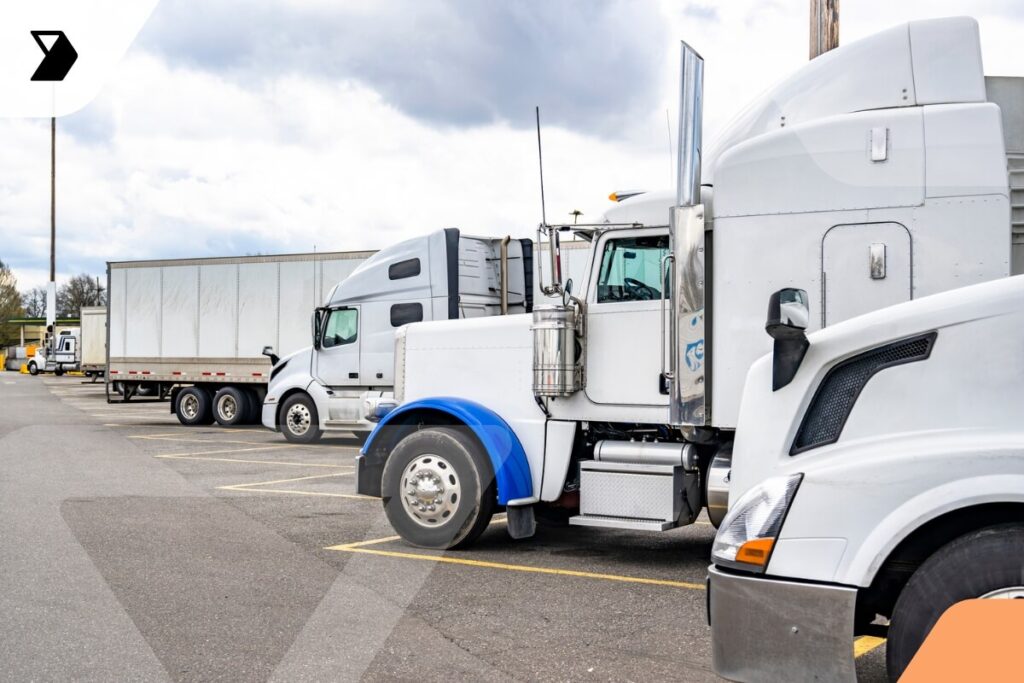Key Differences between Waybill vs Bill of Lading:
Welcome to the world of supply chain logistics where the way goods are documented plays a crucial role in keeping things running smoothly.
Ready to transform your supply chain?

When dealing with the intricacies of documentation, you will come across two important terms: waybill vs bill of lading.
How goods are documented is crucial in ensuring smooth operations within the supply chain. Let’s explore two key documents—the waybill and the bill of lading—to understand their unique roles in logistics better.
In the intricate world of supply chain logistics, documents like the waybill and bill of lading (BOL) are essential for smooth operations. While they share similarities, their functions and applications differ, making it crucial to understand their distinctions. If bills of lading (BOLs) are the primary documents for land-based freight, waybills dominate maritime shipping. Both are integral to the supply chain industry.
This guide explores the key differences between a waybill and a bill of lading, answers questions such as “What is a waybill?” and highlights how innovations like digital waybills and sea waybill OCR enhance supply chain efficiency.
But are these two documents interchangeable? Or does a waybill and a bill of lading mean two entirely different things? What if it’s a little of both? Today’s guide is all about the similarities and differences between a waybill and a bill of lading. We will talk about:
- What are bills of lading and waybills and why they are important?
- What are the key information requirements for both?
- What are typical problems associated related to both documents?
- A detailed look into e-waybills and e-BOLs, and
- How Vector can help you improve your supply chain efficiency
Essential Information included in Waybills and Bill of Ladings
Although both waybills and bills of lading are essential documents in the shipping process, their roles and applications differ significantly based on the nature of the shipment. Understanding the difference between a waybill and a bill of lading is crucial for ensuring smooth operations, avoiding disputes, and choosing the right document for each scenario. The table below highlights the key differences between waybills and bills of lading, clarifying their unique functions within the logistics process.
Waybills vs. Bills Of Lading: What’s The Difference?
Why does drilling down on these definitions matter? Well, like most industries, there’s a lot of terminology that gets thrown around in logistics which can get confusing and cause frustration. So let’s do our part and try to tidy up this corner of the internet.
What do these two documents share in common? They’re both shipping documents and depending on the shipment, you’ll typically need one or the other.
Bills Of Lading
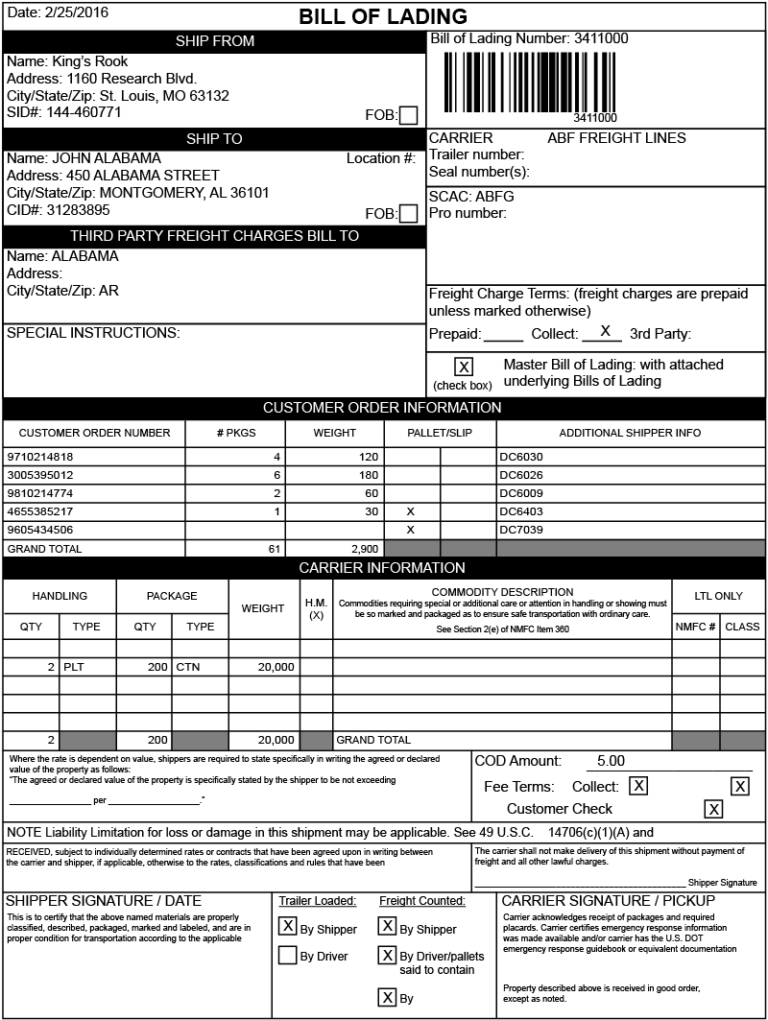
BOLs are probably the most important document in the freight industry because a BOL serves three primary functions:
- Evidence of a contract: A BOL is a contractually binding legal document used as a transport contract between a shipper and a carrier.
- A receipt of goods: A BOL specifies the type, quantity, and destination of the freight a driver is carrying.
- A document of title: A BOL is legal documentation of ownership.
Importance Of Bill Of Lading
With its freight identification marks, liability allocation, and proof of delivery, the bill of lading serves specific functions that keep the global economy moving. Let’s discuss why this document is so important.
- Evidence of delivery and receipt of goods by the consignee: BOL is trusted proof that the carrier has received the goods and is ready to hand over the cargo immediately to the recipient. With this document, both the sender and receiver can have a sense of security and confidence.
- Basis for payment of freight charges: Bill of lading outlines the terms and conditions agreed upon between the shipper and the carrier and becomes the reference point for accurate invoicing and settlement of the shipping costs.
- Documentation of the condition of goods at the time of shipment: BOL allows for documenting the condition of goods at the time of shipment. It includes careful inspections, notes, and descriptions, capturing the physical state of the cargo. With this information, receivers can handle any claims or disputes.
- Allocation of liability for loss or damage to goods during shipment: By clearly stating the terms and conditions of shipping, the bill of lading determines who is liable in case of any unfortunate incident. It outlines the rights, responsibilities, and limitations of each party involved.
- Facilitation of insurance claims: BOL is packed with important information that insurance companies need. In the event of loss, damage, or theft of goods, it helps prove their condition at the time of shipment, details the damages or losses, and outlines the responsibilities of each party.
Waybills
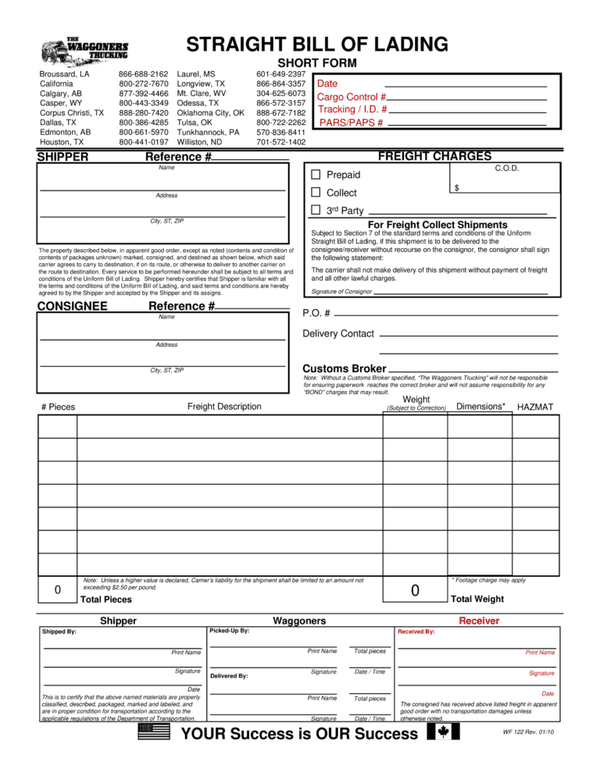
On the other hand, waybills include much of the same information as a BOL but without the power of a contract.
A waybill is a document typically issued by the transporter of the goods and is sometimes called a “straight bill of lading” or a “consignment bill of lading.” It shows basic details like the names and addresses of the sender and receiver. In addition, waybills include registration and identification numbers, as well as a description of the freight goods
Importance Of Waybills
Here are some key advantages of a seaway bill:
- Proof of shipment: A waybill serves as an essential piece of evidence for the transportation of goods. It verifies that the cargo has been handed over to the shipping company for transport. By clearly stating the details of the consignment, such as origin, destination, and the person identified in the document as the receiver, a waybill establishes a record of the transfer of responsibility from the shipper to the carrier.
- Documentation of the quantity and description of goods shipped: Waybills provide an overview of the ocean cargo, including its weight, dimensions, packaging details, and the nature of the goods. This helps in efficient handling, storage, and loading/unloading processes at the destination port.
- Instruction for the carrier to transport the goods: Waybills include explicit instructions for the carrier on how to handle and transport the goods. These include special handling requirements, temperature control specifications, and any other necessary safety precautions.
- Tracking and tracing of the shipment: Each waybill carries a unique identification number which helps in tracking and tracing the cargo throughout its journey. Shippers, carriers, and recipients can access updated information on the location and estimated time of arrival.
- Basis for invoicing and payment of freight charges: Waybills contain important details such as the consignment’s value, freight rates, and additional surcharges, which are then used to calculate the transportation cost. The recipient can verify the charges against the waybill to see if they align with the agreed terms.
Here’s a quick rundown of the primary information these documents include.
The Key Information Needed On Both Waybills & Bills Of Lading
BOLs and waybills both include the following information:
- Shipper name
- Shipper address and contact information
- Carrier name
- Carrier address and contact or driver’s information (identification number, phone number, etc.)
- Consignee name
- Consignee address and contact information
- Port or airport of loading
- Port or airport of unloading
- Ship or vessel’s name and identification number
- Description of freight
- Condition of freight
- Identification marks on cargo
- Number of pieces, packages, or pallets
- Length, width, height, and weight of freight shipment
- Payment information
- Terms of the contract
Common Issues in Shipping Documentation
Like any important document, waybills and bills of lading can sometimes become a source of disputes and issues. Let’s discuss some eBOL benefits, common problems and their implications.
Benefits of Today’s eBOL
01. Inaccurate Or Incomplete Information
Imagine if the description of the goods, the quantities, or even the name of the person receiving them is all messed up. It’s a recipe for confusion and trouble during transportation. That’s why shippers and carriers should double-check and verify every single piece of information before handing out those waybills and bills of lading. If mistakes do come up, they need to fix them right away to prevent disputes down the line.
02. Missing Signatures Or Stamps
Waybills or bills of lading require signatures from both the shipper and the carrier to establish their authenticity and contractual validity. Missing signatures or stamps raise questions about the document’s legitimacy and can result in all sorts of disputes. To prevent these issues, ensure that all required parties sign and stamp the document correctly.
03. Discrepancies Between Different Copies Of The Same Document
Sometimes when you look at different copies of the same waybill or bill of lading, you’ll notice some discrepancies. These happen because of printing errors, mishandling, or even changes made after the original bill of lading was made. Such differences cause a whole lot of confusion about what the parties exactly agreed on. To avoid this, make sure that all the copies of the document are identical and mirror the original document perfectly.
04. Conflicting Interpretations Of Terms & Conditions
Disputes often arise because people have different interpretations of the terms and conditions mentioned in the waybill or bill of lading. These documents typically lay out important aspects such as delivery times, payment terms, and liability for loss or damage.
Vague or ambiguous language gives rise to different understandings and expectations which causes disagreements between shippers and carriers. To tackle this issue, use clear and unambiguous language while drafting the document and get legal advice if necessary.
05. Disputes Related To Delivery Times, Payment Terms, & Liability For Loss Or Damage
Waybills and bills of lading often become focal points of disputes regarding delivery times, payment terms, and liability for loss or damage to the cargo. Disagreements occur if the cargo is not delivered on time or if the payment terms are not met.
Conflicts can also arise if there are disputes over who bears the responsibility for any loss or damage to the goods during transportation. To deal with these issues, everyone involved should clearly understand and agree upon the terms and conditions outlined in the document.
06. Improper Endorsements Or Consignments
Mistakes in endorsements or consignments cause arguments too. When we talk about endorsements, it means passing on the rights and responsibilities for the goods mentioned in the waybill or bill of lading.
If these documents are not properly endorsed or if there are mistakes in the consignments, it can cause conflicts between the parties involved. That’s why it’s really important to be careful when dealing with endorsements and consignments, making sure they correctly represent what all parties want.
Straight Bills Of Lading, Seaway Bills, & Straight Consignments
When is a waybill good enough? When do we need a bill of lading? It’s worth noting that in some countries, the consignee is required to produce a copy of the original BOL as well. If it’s not required, a straight BOL streamlines the receiving process.
The waybill and straight BOL are typically used with prepaid freight when the shipment won’t be sold or traded during transit. A straight BOL will note only one consignee that can accept the freight.
A waybill is suitable for shipments between trusted parties that don’t require letters of credit, settlements through a bank, or other third-party involvement. In other words, a sea waybill is valid instead of a BOL when a shipment is a straight consignment. And again, a straight consignment is a shipment that involves no credit, banking arrangements, or third-party sales of the goods.
A Note On Electronic Waybills & BOLs
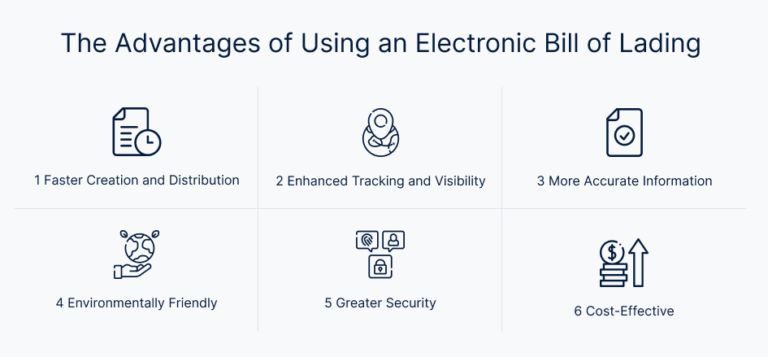
Everything we’ve covered about waybills and BOLs is moving towards a digital standard. Digitized documents like electronic waybills and BOLs will streamline the entire supply chain documentation process. Digitized paperless documents automate manual steps in the trade process. Once paperless, we should see fewer bottleneck issues.
The standardization process of digitized documents will be a challenge. But digitization will enable a greater level of security, visibility, and ease of transaction.
One example is e-waybills, an electronic version of waybills. India began implementing e-waybills across the nation. The idea was to find a way to optimize its freight delivery industry. The basic premise is that e-waybills provide a universal platform—one that allows shippers, carriers, and customers to get on the same page. Or should we say the same computer screen?
One way to think of the Indian e-waybill experiment is as a beta test for e-BOLs in North America and beyond. Regardless, the case for digitized documents is obvious. If you want to learn more about digitized documents, look into Vector, a leading digitization software company based in Silicon Valley.
The Role of Digital Waybills and Sea Waybill OCR
The shift to digital solutions, including sea waybill OCR and eBOLs, has transformed logistics:
- Sea Waybill OCR: Automates data extraction from documents, reducing manual errors.
- Digital Waybills: Enable real-time tracking with unique waybill numbers for shipment visibility.
Enhancing Supply Chain Efficiency With Vector
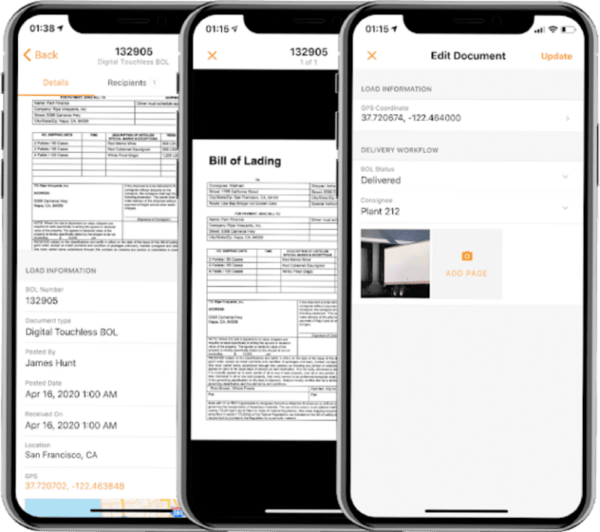
At Vector, our yard management solution is designed to streamline your operations and optimize overall efficiency. Our app simplifies the transition from paper bills of lading to their digital counterparts. With just a simple scan, drivers can swiftly capture a paper BOL and instantly upload it to the cloud. This eliminates the need for manual data entry, saving time and reducing errors associated with traditional paperwork processes.
Vector’s app employs cutting-edge technology to auto-enhance the image quality. It scans barcodes on the document and translates them into digital data. The app is capable of recognizing and converting handwritten information into digital text.
By digitizing the bill of lading process, Vector’s eBOL feature enables faster processing times. The elimination of manual data entry and document handling expedites the entire workflow. This efficiency translates into shorter lead times, improved customer satisfaction, and reduced costs associated with delays.
Vector’s digital solutions contribute to a paperless environment by reducing physical storage requirements. The cloud-based storage provided by Vector also ensures easy access to historical BOL records, facilitating compliance with legal and regulatory requirements.
Our app seamlessly integrates with various transportation management systems (TMS). Once the BOL data is extracted, it is automatically loaded into the integrated TMS, eliminating the need for manual data transfer.
Overcoming Supply Chain Challenges with Digitized Documentation
The supply chain crisis often resembles a shifting kaleidoscope—familiar patterns and recurring challenges appear repeatedly. When attention turns to other pressing matters, another unexpected shortage or disruption brings the focus back to logistics.
When examining the challenges faced by exporters in Asia and importers in the U.S., one striking reality emerges: loading ships for export is often much more straightforward than the complex task of unloading imported goods. This imbalance highlights the difficulties in achieving proper trade equilibrium.
However, hope alone won’t solve these challenges. Progress depends on proactive steps, and one crucial step is adopting clean, digitized waybills and bills of lading. Digitization ensures accuracy and streamlines documentation, helping minimize bottlenecks and keeping the supply chain moving efficiently. Clean documentation is not just a goal—it’s a necessity for overcoming these ongoing hurdles.
Embracing the Future of Waybills and Bills of Lading
Waybills and bills of lading (BOLs) are critical documents in supply chain logistics. They serve as proof of cargo and, in the case of BOLs, facilitate title transfer. However, navigating cross-border transactions can be complex and costly, often plagued by legal delays and disputes.
The key to avoiding these challenges lies in due diligence—understanding the distinct roles of waybills vs. bills of lading and ensuring accurate documentation. As the logistics industry evolves, the future points to digitization, potentially enhanced by blockchain, to simplify processes and strengthen global supply chains.
At Vector, we are committed to helping businesses achieve a seamless, efficient supply chain through innovative solutions like electronic bills of lading and advanced yard management tools. By digitizing critical documents and automating workflows, we’re paving the way for a more connected and streamlined future. Join us to drive your supply chain toward greater efficiency and success.
This post was written by Brian Deines. Brian believes that every day is a referendum on a brand’s relevance, and he’s excited to bring that kind of thinking to the world of modern manufacturing and logistics. He deploys a full-stack of business development, sales, and marketing tools built through years of work in the logistics, packaging, and tier-1 part supply industries serving a customer base comprised of Fortune 1000 OEMs.
Continue reading
Ready to transform your supply chain?
Increase efficiency and productivity. Say goodbye to delays, handwriting errors, and time-intensive manual data entry.



